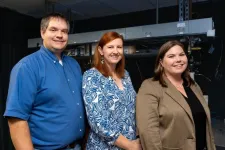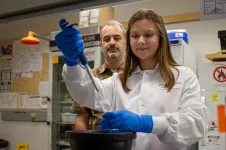One major reason why it has been difficult to develop an effective HIV vaccine is that the virus mutates very rapidly, allowing it to evade the antibody response generated by vaccines.
Several years ago, MIT researchers showed that administering a series of escalating doses of an HIV vaccine over a two-week period could help overcome a part of that challenge by generating larger quantities of neutralizing antibodies. However, a multidose vaccine regimen administered over a short time is not practical for mass vaccination campaigns.
In a new study, the researchers have now found that they can achieve a similar immune response with just two doses, given one week apart. The first dose, which is much smaller, prepares the immune system to respond more powerfully to the second, larger dose.
This study, which was performed by bringing together computational modeling and experiments in mice, used an HIV envelope protein as the vaccine. A single-dose version of this vaccine is now in clinical trials, and the researchers hope to establish another study group that will receive the vaccine on a two-dose schedule.
“By bringing together the physical and life sciences, we shed light on some basic immunological questions that helped develop this two-dose schedule to mimic the multiple-dose regimen,” says Arup Chakraborty, the John M. Deutch Institute Professor at MIT and a member of MIT’s Institute for Medical Engineering and Science and the Ragon Institute of MIT, MGH and Harvard University.
This approach may also generalize to vaccines for other diseases, Chakraborty notes.
Chakraborty and Darrell Irvine, a former MIT professor of biological engineering and materials science and engineering and member of the Koch Institute for Integrative Cancer Research, who is now a professor of immunology and microbiology at the Scripps Research Institute, are the senior authors of the study, which appears in Science Immunology. The lead authors of the paper are Sachin Bhagchandani PhD ’23 and Leerang Yang PhD ’24.
Neutralizing antibodies
Each year, HIV infects more than 1 million people around the world, and some of those people do not have access to antiviral drugs. An effective vaccine could prevent many of those infections. One promising vaccine now in clinical trials consists of an HIV protein called an envelope trimer, along with a nanoparticle called SMNP. The nanoparticle, developed by Irvine’s lab, acts as an adjuvant that helps recruit a stronger B cell response to the vaccine.
In clinical trials, this vaccine and other experimental vaccines have been given as just one dose. However, there is growing evidence that a series of doses is more effective at generating broadly neutralizing antibodies. The seven-dose regimen, the researchers believe, works well because it mimics what happens when the body is exposed to a virus: The immune system builds up a strong response as more viral proteins, or antigens, accumulate in the body.
In the new study, the MIT team investigated how this response develops and explored whether they could achieve the same effect using a smaller number of vaccine doses.
“Giving seven doses just isn’t feasible for mass vaccination,” Bhagchandani says. “We wanted to identify some of the critical elements necessary for the success of this escalating dose, and to explore whether that knowledge could allow us to reduce the number of doses.”
The researchers began by comparing the effects of one, two, three, four, five, six, or seven doses, all given over a 12-day period. They initially found that while three or more doses generated strong antibody responses, two doses did not. However, by tweaking the dose intervals and ratios, the researchers discovered that giving 20 percent of the vaccine in the first dose and 80 percent in a second dose, seven days later, achieved just as good a response as the seven-dose schedule.
“It was clear that understanding the mechanisms behind this phenomenon would be crucial for future clinical translation,” Yang says. “Even if the ideal dosing ratio and timing may differ for humans, the underlying mechanistic principles will likely remain the same.”
Using a computational model, the researchers explored what was happening in each of these dosing scenarios. This work showed that when all of the vaccine is given as one dose, most of the antigen gets chopped into fragments before it reaches the lymph nodes. Lymph nodes are where B cells become activated to target a particular antigen, within structures known as germinal centers.
When only a tiny amount of the intact antigen reaches these germinal centers, B cells can’t come up with a strong response against that antigen.
However, a very small number of B cells do arise that produce antibodies targeting the intact antigen. So, giving a small amount in the first dose does not “waste” much antigen but allows some B cells and antibodies to develop. If a second, larger dose is given a week later, those antibodies bind to the antigen before it can be broken down and escort it into the lymph node. This allows more B cells to be exposed to that antigen and eventually leads to a large population of B cells that can target it.
“The early doses generate some small amounts of antibody, and that’s enough to then bind to the vaccine of the later doses, protect it, and target it to the lymph node. That's how we realized that we don't need to give seven doses,” Bhagchandani says. “A small initial dose will generate this antibody and then when you give the larger dose, it can again be protected because that antibody will bind to it and traffic it to the lymph node.”
T-cell boost
Those antigens may stay in the germinal centers for weeks or even longer, allowing more B cells to come in and be exposed to them, making it more likely that diverse types of antibodies will develop.
The researchers also found that the two-dose schedule induces a stronger T-cell response. The first dose activates dendritic cells, which promote inflammation and T-cell activation. Then, when the second dose arrives, even more dendritic cells are stimulated, further boosting the T-cell response.
Overall, the two-dose regimen resulted in a fivefold improvement in the T-cell response and a 60-fold improvement in the antibody response, compared to a single vaccine dose.
“Reducing the ‘escalating dose’ strategy down to two shots makes it much more practical for clinical implementation. Further, a number of technologies are in development that could mimic the two-dose exposure in a single shot, which could become ideal for mass vaccination campaigns,” Irvine says.
The researchers are now studying this vaccine strategy in a nonhuman primate model. They are also working on specialized materials that can deliver the second dose over an extended period of time, which could further enhance the immune response.
The research was funded by the Koch Institute Support (core) Grant from the National Cancer Institute, the National Institutes of Health, and the Ragon Institute of MIT, MGH, and Harvard.
###
Written by Anne Trafton, MIT News
END




